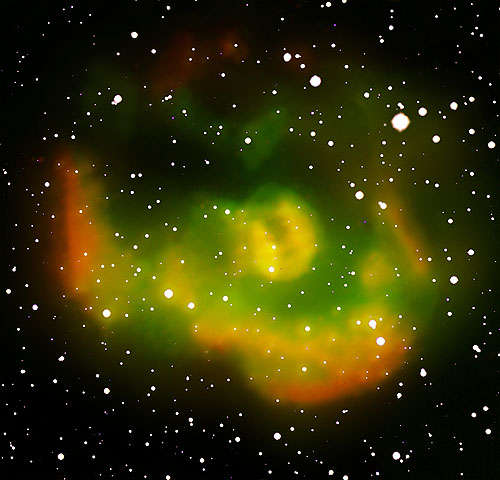 | |||
|
| Home > Public Information > Scientific Highlights > 2006 > A New Planetary Nebula Discovered by IPHAS |
A New Planetary Nebula Discovered by IPHASINT+WFC, WHT+ISIS
The INT/WFC Photometric H-alpha Survey of the Northern Galactic Plane (IPHAS) is currently mapping 1800 degrees2
of the Northern Galactic plane (a band between b= -5 to +5 degrees) in three filters using the INT Wide Field Camera at the Observatorio del Roque de los Muchachos (La Palma, Spain). The survey is
an international collaboration of 15 institutes. A narrow-band Hα and two Sloan filters (r' and i') are used for matched 120, 30, and 10 s exposures, respectively, spanning the magnitude range r'=13 to 20 mag for point sources.
IPHAS is the first fully-photometric Hα survey of the Galactic plane. It will discover around 40,000 new emission-line stars, including young stars (T Tau, Herbig AeBe stars, etc.), evolved stars (post-AGB, LBVs, etc.) as well as binaries
(CVs, symbiotic stars, etc.) in addition to thousands of extended nebulae such as Planetary Nebulae (PNe), H-H objects, HII regions, SN remnants, etc.
Two systematic searches for PNe are currently conducted on the IPHAS data. Extended PNe are searched visually from continuum subtracted mosaics of IPHAS data while the compact PNe search is based on IPHAS catalog information. The first step to select compact PN candidates is to filter out all objects which are too close to the borders of the CCDs or to the areas of bad pixels as well as sources which are not classified as stars or extended objects. Also a first cut in the r' - Hα plane is made removing all objects with r' - Hα < (r - Hα)median + 1, which removes the majority of the stellar locus objects. They also remove sources were the positional match between individual images is worse than 0.65 arcsec. Together with the visual search for extended PNe they expect to find a total of 500-1000 new Galactic PNe. The discovery of the first new PN from this survey is an unusual object located at a large galactocentric distance and has a very low oxygen abundance. The so-called "Príncipes de Asturias" nebula shows an intricate morphology: there is an inner ring surrounding the central star, bright inner lobes with an enhanced waist, and very faint lobular extensions reaching up to more than 100''.
 The "Príncipes de Asturias" nebula or IPHAS PN-1 (more information can be found in Mampaso et al., 2006, A&A, 458, 203). Credit: Antonio Mampaso, Romano Corradi and the IPHAS Collaboration.[ JPEG | TIFF ] The image below is another example of the new planetary nebula discovered by the IPHAS collaboration. It is a two-colour image, red for H-alpha and green for [OIII], and it has been obtained using the Wide-Field Camera on the Isaac Newton Telescope. North is to the right and East is to the top. The exposure times amounted 50 minutes in H-alpha and 30 minutes in [OIII]. The nebula was confirmed to be a relatively old planetary nebula using the ISIS spectrograph on the William Herschel Telescope. Credit: Laurence Sabin, Nick Wright and the IPHAS Collaboration.
 The Ear Nebulae is of the new PNe discovered by IPHAS. This is a two-colour image, red for Hα and green for [OIII]. North is to the right and East is to the top. Credit: Laurence Sabin, Nick Wright and the IPHAS Collaboration. [ JPEG | TIFF ] References:
|
| Top | Back |
|

